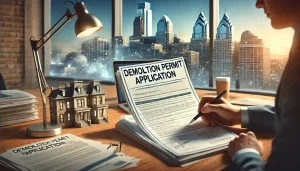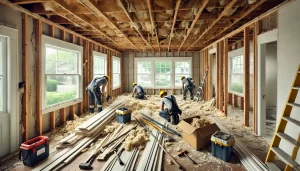From the ashes of the old, the new often rises. It’s a principle that’s as true in urban development as it is in nature. Take, for example, the Pratt Street Power Plant in Baltimore. Built in the early 20th century, it survived the great Baltimore Fire of 1904, powering the city’s streetcar network until 1973. Today, it’s a bustling hub of culture and commerce, housing everything from art spaces to restaurants.
Similarly, the town of Gardnerville breathed new life into a dilapidated gas station, transforming it into a thriving community center. Once a hub for high schoolers and retirees alike, the station fell into disrepair in the 90s. Now, it’s a vibrant meeting space, complete with modern amenities like electric car charging stations. These stories show us that repurposing industrial sites not only preserves history but also creates thriving community spaces.
The Value of Repurposing Demolished Industrial Sites
Exploring the realm of repurposing demolished industrial sites, we unearth a treasure trove of benefits. These benefits span the environmental, social, and community spheres, proving that repurposing is a promising and rewarding path to pursue.
Environmental Benefits
This value path contributes considerably to environmental sustenance. For instance, sustainable demolition practices, such as reusing or recycling materials like doors, windows, concrete, metals, and wood, foster efficient resource use and reduce pollution. When industrial sites, otherwise subjected to standard demolition, get repurposed, it results in less waste and cleaner air. Importantly, it also aids in controlling soil and groundwater contamination. Needless to say, cultivating these practices helps maintain a healthy ecosystem and biodiversity.
Consider the case of the Pratt Street Power Plant in Baltimore. Originally a power source for the city and later a brownfield site post its operational cessation in 1973, it withstood the test of time and renaissance to accommodate office, restaurant, and cultural tenants today. The repurposing of this potentially harmful brownfield site reduces the environmental impact while breathing new life into a historically significant industrial structure.
Social and Community Benefits
Shifting the lens to view the social and community canvas, the value of repurposing seems to hold even more weight. Reusing idle and stagnant industrial sites for community centers or urban nature parks eliminates community eyesores and brings a fresh wave of positive social and economic development. The introduction of new hubs for community interaction and activity can significantly enhance the local quality of life.
Take the example of the erstwhile run-down gas station in the town of Gardnerville. After a smart transformation into a thriving community meeting space that includes electric car charging stations, it exudes positivity. Through its rebirth, the gas station has once again become a central point for local non-profits and community activities, devoid of its former stigma. Thus, repurposing such sites injects a much-needed vitality into urban spaces, promoting community spirit and encouraging local economic advancement.
Planning and Design Considerations
Diving deeper into the process, it’s crucial to explore the comprehensive planning considerations critical to the project’s success. Let’s delve into major steps such as assessing site potential and incorporating community input.
Assessing Site Potential
A paramount first move in repurposing a site is a thorough evaluation of its structural integrity. To ensure safety and viability, experts conduct detailed examinations of the foundation, walls, and roof, pinpointing weaknesses or areas needing repair. They also assess the building’s load-bearing capacity to ascertain if it suffices for the new use of the space. Reinforcements or additional support may become necessary. Another critical aspect of site evaluation revolves around possible contamination of the site. Potential contamination could pose significant financial and legal complications, deterring both investors and developers. However, current changes in federal law of some countries provide some relief to new purchasers of contaminated properties, easing the burden of potential cleanup costs and liability.
Incorporating Community Input
Once technical feasibility is nailed down, the second crucial step involves community input. We believe that community participation plays a fundamental role in ensuring the success and sustainability of the redevelopment project. Informed, engaged residents can provide valuable insight into local needs, preferences, and concerns. By listening to and integrating the community’s voice, developers can design spaces that not only uplift the physical surroundings but also meet the residents’ requirements and enhance their quality of life. For instance, the Gardnerville gas station was transformed into a welcome center and community meeting space as per local needs. Its reincarnation as a community hub contributed significantly to local social and economic development, showcasing the power of planning and design rooted in community input.
Successful Case Studies
In this section, we turn our attention to some of the most successful adaptive reuse projects globally. Each case study showcases the transformation of demolished industrial sites into vibrant community assets.
Urban Parks Transformations in Major Cities
One standout example is the conversion of the High Line in New York City. This ingenious project repurposed a disused railway track into an elevated, breathtaking urban park — a green oasis amongst the skyscrapers. Its successful implementation sparked revitalization in the surrounding neighborhoods, resulting in increased property values and tourism influx, thereby demonstrating the manifold benefits of adaptive reuse.
Another noteworthy case is the Tate Modern in London. Housed in a former power station, this art museum has flawlessly preserved the industrial character of the original building and successfully transitioned it into a stunning space for art exhibitions, visited by millions each year.
Finally, we look at Baltimore’s historic Pratt Street Power Plant. Built between 1900 and 1909, it served as the city’s significant source of power until its operations ceased in 1973. After years of abandonment, this site underwent a series of transformations, having been used briefly as an amusement park and nightclub. Today, the structure houses a mix of office, restaurant and cultural spaces, having managed to unite its historical essence with present-day utility.
Innovative Design Features
Turning our focus to architecture and design, the transformation of Buffalo’s waterfront is a testament to innovative, yet thoughtful repurposing. The ruins of the Erie Canal were discovered during the demolition of an old NHL arena in 2009. This very piece of history, once hidden away, was brought to the surface and integrated into the new waterfront design, honoring the area’s past while still encouraging new development.
In Rushville, Indiana, an old Masonic Temple stood empty for nearly two decades before being bought and converted into a mixed-use city center. The renovation expertly married the old and the new, maintaining the historic exterior while introducing modern facilities inside — a shining example of the creative possibilities that adaptive reuse represents.
Each of these projects accentuates the vital role architecture and design play in the success of adaptive reuse endeavors. It’s about form and function, but also about honoring a location’s past while ushering it into the future.
Overcoming Challenges
Optimizing the adaptive reuse of dismantled industrial sites into community parks involves overcoming several challenges. In this section, we’ll explore two of these hurdles: addressing soil and water contamination, and the issue of funding and resource allocation.
Addressing Soil and Water Contamination
Contamination poses a significant challenge in the rejuvenation of former industrial sites. Current and past landowners often face potential legal and financial liability tied to who shoulders responsibility for decontamination. This holds true for both soil and water contamination.
For instance, Gardnerville’s repurposing of a dilapidated gas station into a community welcome center saw the town grapple with soil contamination from leaking fuel tanks. The town used Brownfield funds to remove these tanks, replacing them with a stormwater retention and diversion system that mitigated local flooding concerns.
Environmental decontamination and rejuvenation are vital steps in transforming previous industrial sites into vibrant and sustainable community spaces. The remedial measures taken on contaminated sites provide opportunities to introduce greener initiatives like stormwater management systems and electric car charging stations.
Funding and Resource Allocation
Securing funds is integral to the success of adaptive reuse projects. From government grants and incentives to partnerships with private investors and financial institutions, there are numerous financing options available for these initiatives. In some cases, crowdfunding platforms and community fundraising drives have proven effective, allowing individuals to contribute directly to the preservation and revitalization of their local communities.
Take the case of an old National Hockey League (NHL) arena in Buffalo that was repurposed into an Erie Canal-themed waterfront park. In 2008, the area that would become the park saw zero visitors. Fast forward to 2015, after the completion of the adaptive reuse, and this number soared to over one million visitors annually. Investment beyond private real estate boomed, leading to an urban renaissance that saw increased demand for public works and infrastructure improvements.
Indeed, the switch from dereliction to celebration requires careful planning and strategic financial management. Yet with these, the financial challenges that accompany adaptive reuse projects can be surmountable, ensuring the preservation of historical structures and the creation of vibrant and sustainable spaces for future generations.
Conclusion
We’ve journeyed through the transformative power of adaptive reuse, turning dilapidated industrial sites into thriving community parks. We’ve seen how cities like New York and London have breathed new life into forgotten spaces, creating environmental and social assets. We’ve also navigated the challenges, from contamination issues to funding hurdles, understanding that the demolition in Baltimore and Gardnerville’s success stories didn’t come without effort. But it’s clear, the rewards outweigh the obstacles. Repurposing these sites isn’t just about beautification; it’s about sustainability, community, and preserving our history. It’s about giving old sites a new narrative, one that benefits us all. As we move forward, let’s continue to champion these adaptive reuse projects, because every derelict structure holds the potential to become our next beloved community park.










